Electronic Data Interchange (EDI) Transactions Guide
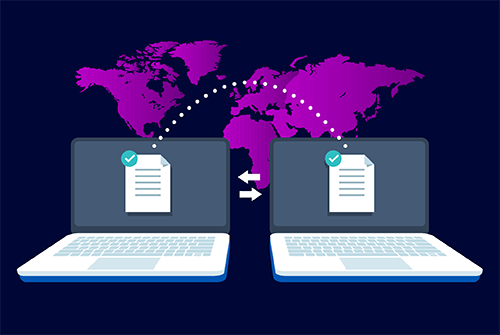
Use this guide to understand why EDI software is critical to the supply chain and learn every EDI transaction code by industry.
Here is everything you need to know about EDI transactions:
- What are EDI Transactions?
- 7 Common EDI Transactions
- What is an EDI Standard?
- Common Types of EDI Communication Standards
- EDI Communication Options
- EDI Transaction Codes
- EDI Transactions within the Cleo Cockpit
What are EDI Transactions?
EDI transactions are standardized electronic business documents used by trading partners to send and receive business information, such as when one company wants to electronically send an EDI order to another organization.
EDI transactions (EDI codes) were designed to be standardized and are independent of the communications used by companies or the software technology that sends and receives the EDI data.
Companies and trading partners exchange these documents using EDI standards to automate and streamline purchase orders, invoices, acknowledgments, payments, tracking, and other reports.
Any EDI transaction document must contain a certain minimum amount of vital data. Without these EDI compliance requirements, an EDI document becomes useless. Adhering to strict EDI feed formatting rules helps define precisely how and where each part of data on the document will be found and used. Each document is assigned one of the dozens of transaction numbers from the EDI public format.
To see an EDI transaction within an EDI dashboard, see this piece for an explanation of the EDI interface.
For example, in EDI order processing, a purchase order (PO) is given the EDI transaction number 850 and the invoice transaction number is 810. So, when an EDI translator receives an EDI 850 PO document, it instantly recognizes the EDI order number, the company name of the buyer, items in the order, and the price per item.
It's the automated sending and receiving of EDI transactions using efficient EDI integration that improves the overall data transfer process between internal and external systems, applications, and cloud ecosystems.
Anything you purchase, any insurance document you file, any government form you report, any text message you send - all of those actions are backed by EDI processes and individual EDI transactions.
7 Common Types of EDI Transactions
Many of the largest corporations in the world require the use of EDI transactions to do business. Walmart mandates the sending of EDI transactions using AS2, so all companies seeking to do business with the retail giant must be EDI capable.
Here are 7 common EDI codes, complete with example EDI example data from the Cleo EDI interface, that you will likely use in communicating with your trading partners:
EDI 856: Ship Notice/Manifest
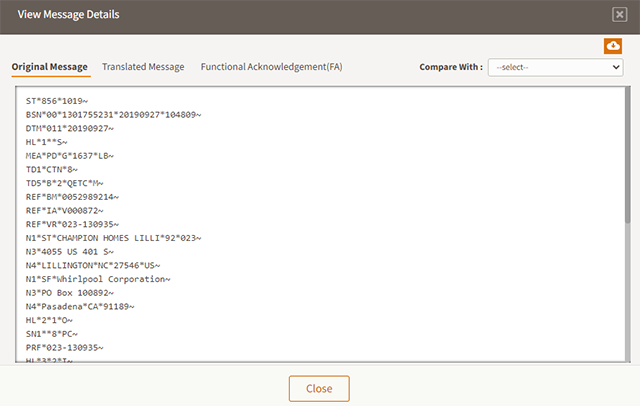
EDI 810: Invoice
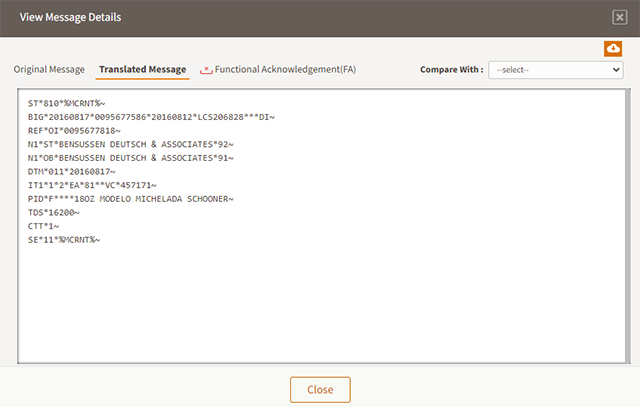
EDI 850: Purchase Order
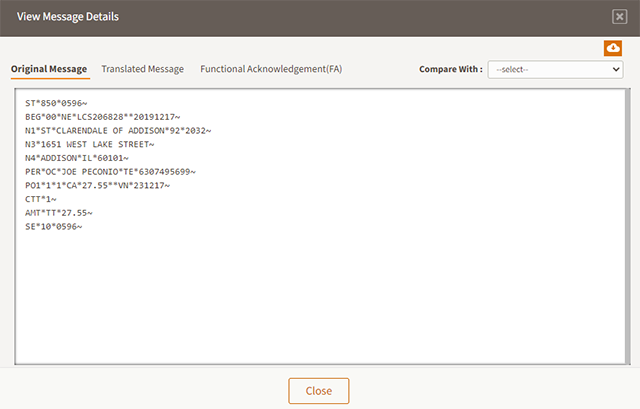
EDI 855: Purchase Order Acknowledgment
The EDI 855 is a response to a Purchase Order (EDI 850), usually sent by retailers to their suppliers. It confirms the order receipt and outlines the agreement. While including accepted quantities, item details, prices, shipping info, delivery date, and locations.
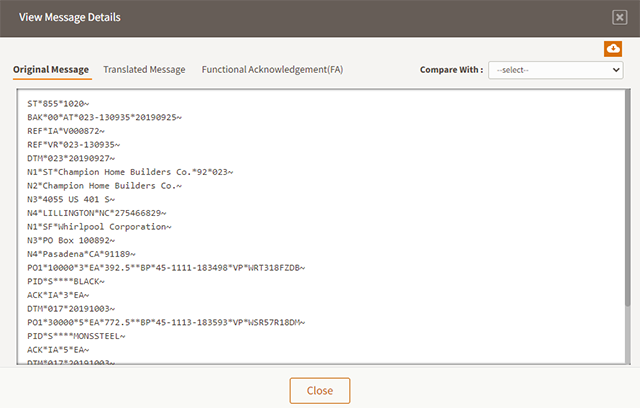
EDI 820: Payment Order/Remittance Advice
The EDI 820 is sent by suppliers in response to the EDI 810 Invoice. It provides payment details like amounts and dates, streamlining transactions and enhancing accuracy between partners.
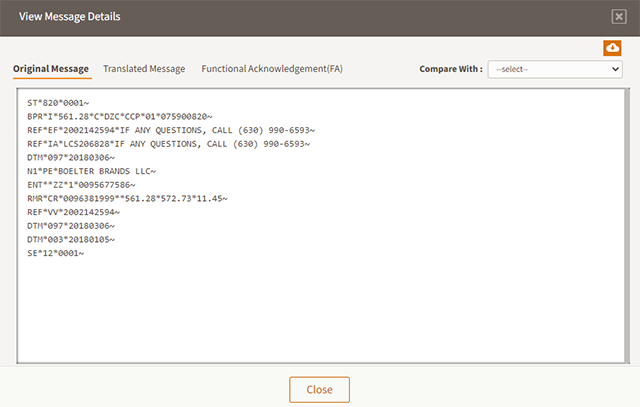
EDI 997: Functional Acknowledgment
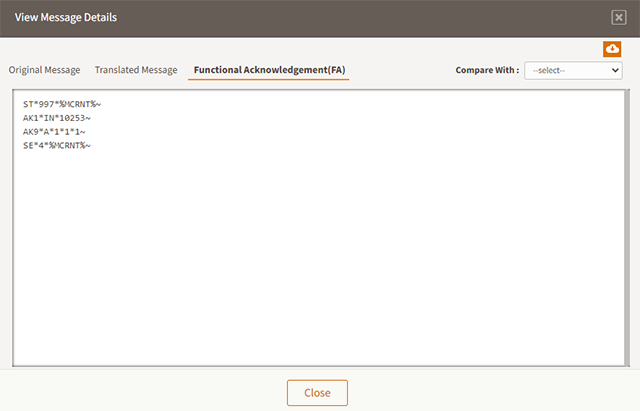
EDI 940: Warehouse Shipping Order
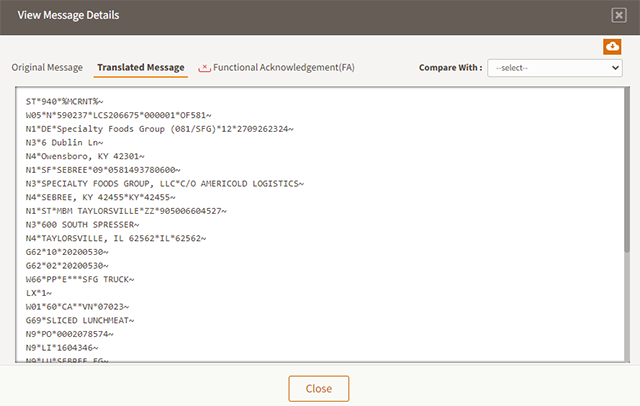
Because there are hundreds of EDI transaction types, organizations follow designated EDI standards to ensure uniform formats for the inter-industry electronic exchange of business documents between trading partners.

Level Up Your Supply Chain: Explore Our EDI Solution
You’ve taken the first step towards a smoother supply chain by finding this blog - now discover how our EDI solution automates data exchange, saving you time and boosting efficiency.
What is an EDI Standard?
EDI communication standards are the requirements for the format and composition of EDI documents. EDI standards delineate the correct order and location of units of data in a given EDI document.
All electronic data interchange transactions are made up of the following parts:
Element - The data elements within an EDI document are individual lines of information. For example, a document like a purchase order or an invoice will contain data elements such as city, state, item number, or cost. Elements are the smallest component in an EDI standard.
Segments - Segments are composed of a group of elements. In an EDI document, each section of the document is described by a particular segment. Examples of segments include the beginning of a purchase order, the company, street addresses, etc.
Transaction Sets - Also referred to as an EDI message or EDI transactions. Once segments are collected in a predetermined format, they form the completed EDI document or transaction sets.
Electronic data interchange works depending on which EDI standards are required to format a message. Ultimately, since EDI documents are managed and interpreted by computers, transferred data must be formatted in a way that the computers of both parties can understand. The main purpose of EDI standard formats is to minimize communication complications and costs of redundancies or fines, often called chargebacks.
Common EDI Communication Standards
1. ANSI ASC X12
ANSI (American National Standards) ASC (Accredited Standards Committee) X12 goes by more than one pseudonym. This standard is also sometimes called ANSI X12 Standard or just simply X12. But regardless of the terminology, ANSI ASC X12 includes EDI standards used to communicate digital B2B transactions for various global business processes. EDI X12 standards allow consistency among business documents and other kinds of enterprise functionality.
There are more than 300 different types of X12 EDI standards, all delegated by a different three-digit number, for numerous industries such as finance, government, health care, insurance, transportation, and others. ANSI ASC X12 also develops standards for CICA (Context Inspired Component Architecture) and XML schemas.
2. TRADACOMS
TRADACOMS (TRAding DAA COMmunicationS) is the primary EDI standard for domestic trading in the United Kingdom, specifically the UK retail industry. While somewhat similar to the EDIFACT standard, TRADACOMS uses multi messages instead of relying on a format of single messaging. TRADACOMS communication is comprised of 26 messages structured in a hierarchy.
Each TRADACOMS message, much like EDIFACT, is given a six-letter application reference. For example, an invoice message is INVFIL, a payment order is PAYORD, a utility bill is UTLHDR, and so on.
3. UN/EDIFACT
UN/EDIFACT, which is short for United Nations rules for Electronic Data Interchange for Administration, Commerce, and Transport, is a set of internationally standardized communication guidelines for exchanged data tags and message types between computer systems in different networks. UN/EDIFACT standards structure data into segments, segments into messages, and messages into an interactive exchange protocol.
The syntax rules for EDIFACT describe the message (nesting, character sets, structures, etc.) The data tags detail the different types of data being exchanged and how each is represented. The message types are also known as UNSMs (United Nations Standard Messages).
4. ODETTE
ODETTE stands for Organization of Data Exchange by Tele Transmission in Europe and creates data exchange and communications standards for the European automotive industry. It is similar to North America's AIAG (Automotive Industry Action Group). ODETTE develops protocols such as OFTP and the more advanced OFTP2, which provides enhanced security through encryption methods and digital certificates for EDI data exchange.
Deploying B2B and MFT (managed file transfer) solutions that are ODETTE-certified for OFTP and OFTP2 allows a company to securely and efficiently communicate with various software to successfully exchange data.
Other common EDI standards include:
- RosettaNet, based on XML, is used broadly in the supply chain, manufacturing, and services industries
- GS1 EDI is used in retail globally
- HL7 required by HIPAA regulation is predominant in U.S. healthcare
The Importance of EDI Standards
One of the most common complaints those in the technology world have had about EDI is due to its rigid standardization. However, this very same standardization has helped EDI stick around for as long as it has and become a way of life for enterprises. Without standardization, it becomes difficult to maintain and scale B2B data exchanges.
A lack of true EDI standards that dictate a universal format is one reason that APIs have not replaced EDI when it comes to B2B-type data exchanges. APIs can be customized to do just about anything, which means developers a pretty wide range of what he or she can do to meet the requirements of the business. Such wide-ranging business rules tend to not scale well in most organizations.
But it's the hundreds of specific EDI transaction codes that really bring the business language together. What exactly, though, is it that makes these EDI transaction sets go?
EDI Communications Options
Every organization that needs to connect with trading partners must first ask themselves, "What is the best way to send and receive information and documents?" And while there are multiple avenues for a company to take business communication, data interchange ultimately comes down to AS2 vs. VAN.
EDI AS2
With AS2 (applicability statement 2), data such as EDI, XML, and others are sent and received via the internet using an HTTP protocol (TCP/IP) through a certified server. AS2 offers a securely encrypted process without costly annual or transaction fees for unlimited data. In today's digital ecosystem, AS2 is considered the best way to integrate with trading partners and has been widely implemented across many industries.
AS2 can handle any type of file format and requires message disposition/delivery notifications (MNDs) to alert a trading partner when a document or data has been delivered or received. AS2 also can be deployed using in-house IT resources or outsourced through a cloud-based EDI vendor.
With AS2, what it all comes down to is enabling a better way to send data securely and directly from one source to another.
EDI VAN
An EDI VAN (value-added network) should efficiently deliver EDI transactions through a single connection. A hosted VAN service enables the communication between a traditional VAN and a private network or internet-connected trading partner. Simply put, a VAN is a communication channel that moves and manages data from point A to point B - kind of like a post office. In a VAN, trading partners each possess a mailbox as data is delivered between each mailbox.
This streamlined method is meant to lower the document-by-document processing costs by way of a centralized system with real-time tracking, communication management, multiple connectivity options, local data integration, and rapid message delivery. However, relying on a VAN has become an outdated way of doing business, especially with more modernized and cost-effective technology options available that offer end-to-end connectivity and solutions to complex integration.
EDI Transaction Codes
EDI transactions are used by every industry. See the EDI document types below to understand how EDI applies in each industry-specific communication.
The list below will segment EDI industry standards, including EDI transportation transactions, EDI transactions for healthcare, and more. The list will also include a compressive catalog of X12 EDI sets, from the EDI 830 transaction for the supply chain to the EDI 837 transaction for healthcare claims to the EDI 997 transaction for functional acknowledgment - and everything in between.
EDI Document Types: Transportation and Logistics
EDI 104: Air Shipment Information
EDI 106: Motor Carrier Rate Proposal
EDI 107: Request for Motor Carrier Rate Proposal
EDI 108: Response to a Motor Carrier Rate Proposal
EDI 109: Vessel Content Details
EDI 110: Air Freight Details and Invoice
EDI 120: Vehicle Shipping Order
EDI 121: Vehicle Service
EDI 125: Multilevel Railcar Load Details
EDI 126: Vehicle Application Advice
EDI 127: Vehicle Baying Order
EDI 128: Dealer Information
EDI 129: Vehicle Carrier Rate Update
EDI 160: Transportation Automatic Equipment Identification
EDI 161: Train Sheet
EDI 163: Transportation Appointment Schedule Information
EDI 204: Motor Carrier Load Tender
EDI 210: Motor Carrier Freight Details and Invoice
EDI 211: Motor Carrier Bill of Lading
EDI 212: Motor Carrier Delivery Trailer Manifest
EDI 213: Motor Carrier Shipment Status Inquiry
EDI 214: Transportation Carrier Ship. Status Message
EDI 215: Motor Carrier Pick-up Manifest
EDI 216: Motor Carrier Shipment Pick-up Notification
EDI 217: Motor Carrier Loading and Route Guide
EDI 219: Logistics Service Request
EDI 220: Logistics Service Response
EDI 222: Cartage Work Assignment
EDI 223: Consolidators Freight Bill and Invoice
EDI 224: Motor Carrier Summary Freight Bill Manifest
EDI 225: Response to a Cartage Work Assignment
EDI 227: Trailer Usage Report
EDI 228: Equipment Inspection Report
EDI 240: Motor Carrier Package Status
EDI 250: Purchase Order Shipment Management Document
EDI 300: Reservation (Booking Request) (Ocean)
EDI 301: Confirmation (Ocean)
EDI 303: Booking Cancellation (Ocean)
EDI 304: Shipping Instructions
EDI 309: Customs Manifest
EDI 310: Freight Receipt and Invoice (Ocean)
EDI 311: Canada Customs Information
EDI 312: Arrival Notice (Ocean)
EDI 313: Shipment Status Inquiry (Ocean)
EDI 315: Status Details (Ocean)
EDI 317: Delivery/Pickup Order
EDI 319: Terminal Information
EDI 322: Terminal Operations and Intermodal Ramp Activity
EDI 323: Vessel Schedule and Itinerary (Ocean)
EDI 324: Vessel Stow Plan (Ocean)
EDI 325: Consolidation of Goods in Container
EDI 326: Consignment Summary List
EDI 350: Customs Status Information
EDI 352: U.S. Customs Carrier General Order Status
EDI 353: Customs Events Advisory Details
EDI 354: U.S. Customs Auto. Manifest Archive Status
EDI 355: U.S. Customs Acceptance/Rejection
EDI 356: U.S. Customs Permit to Transfer Request
EDI 357: U.S. Customs In-Bond Information
EDI 358: Customs Consist Information
EDI 359: Customs Customer Profile Management
EDI 361: Carrier Interchange Agreement (Ocean)
EDI 404: Rail Carrier Shipment Information
EDI 410: Rail Carrier Freight Details and Invoice
EDI 412: Trailer or Container Repair Billing
EDI 414: Rail Carhire Settlements
EDI 417: Rail Carrier Waybill Interchange
EDI 418: Rail Advance Interchange Consist
EDI 419: Advance Car Disposition
EDI 420: Car Handling Information
EDI 421: Estimated Time of Arrival & Car Scheduling
EDI 422: Equipment Order
EDI 423: Rail Industrial Switch List
EDI 424: Rail Carrier Services Settlement
EDI 425: Rail Waybill Request
EDI 426: Rail Revenue Waybill
EDI 429: Railroad Retirement Activity
EDI 431: Railroad Station Master File
EDI 432: Rail Deprescription
EDI 433: Railroad Reciprocal Switch File
EDI 434: Railroad Mark Register Update Activity
EDI 435: Standard Transportation Commodity Code Master
EDI 436: Locomotive Information
EDI 437: Railroad Junctions & Interchanges Activity
EDI 440: Shipment Weights
EDI 451: Railroad Event Report
EDI 452: Railroad Problem Log Inquiry or Advice
EDI 453: Railroad Service Commitment Advice
EDI 455: Railroad Parameter Trace Registration
EDI 456: Railroad Equipment Inquiry or Advice
EDI 460: Railroad Price Distribution Request or Response
EDI 463: Rail Rate Reply
EDI 466: Rate Request
EDI 468: Rate Docket Journal Log
EDI 470: Railroad Clearance
EDI 475: Rail Route File Maintenance
EDI 485: Ratemaking Action
EDI 486: Rate Docket Expiration
EDI 490: Rate Group Definition
EDI 492: Miscellaneous Rates
EDI 494: Rail Scale Rates
EDI 601: U.S. Customs Export Shipment Information
EDI 603: Transportation Equipment Registration
EDI 715: Intermodal Group Loading Plan
EDI 854: Shipment Delivery Discrepancy Info.
EDI 858: Shipment Information
EDI 859: Freight Invoice
EDI 920: Loss or Damage Claim: Gen. Commodities
EDI 924: Loss or Damage Claim: Motor Vehicle
EDI 925: Claim Tracer
EDI 926: Claim Status Report and Tracer Reply
EDI 928: Automotive Inspection Detail
EDI 980: Functional Group Totals
EDI 990: Response to a Load Tender
EDI 998: Set Cancellation
EDI Document Types: Manufacturing and Retail
EDI 101: Name and Address Lists
EDI 140: Product Registration
EDI 141: Product Service Claim Response
EDI 142: Product Service Claim
EDI 143: Product Service Notification
EDI 159: Motion Picture Booking Confirmation
EDI 170: Revenue Receipts Statement
EDI 180: Return Merchandise Authorization & Notification
EDI 244: Product Source Information
EDI 290: Cooperative Advertising Agreements
EDI 503: Pricing History
EDI 504: Clauses and Provisions
EDI 620: Excavation Communication
EDI 625: Well Information
EDI 753: Request For Routing Instructions
EDI 754: Routing Instructions
EDI 816: Organizational Relationships
EDI 818: Commission Sales Report
EDI 830: Planning Schedule w/ Release Capability
The EDI 830 is sent by manufacturers to trading partners in response to the EDI 852 Product Activity Data. It shares production and delivery plans, including quantities and schedules.
EDI 832: Price/Sales Catalog
EDI 840: Request for Quotation (RFQ)
An EDI 840 is used to request price and product information from suppliers. Buyers send RFQs, and suppliers receive them to provide quotes and initiate procurement negotiations.
EDI 841: Specifications/Technical Information
EDI 842: Nonconformance Report
EDI 843: Response to Request for Quotation
EDI 845: Price Authorization Acknowledgment/Status
EDI 846: Inventory Inquiry/Advice
EDI 847: Material Claim
EDI 848: Material Safety Data Sheet
EDI 850: Purchase Order
EDI 851: Asset Schedule
EDI 852: Product Activity Data
The EDI 852 is sent by suppliers to retailers in response to the EDI 846 Inventory Inquiry/Advice. It provides sales and inventory insights, aiding supply chain management and collaboration between partners.
EDI 853: Routing and Carrier Instruction
EDI 855: Purchase Order Acknowledgment
EDI 856: Ship Notice/Manifest
EDI 857: Shipment and Billing Notice
The EDI 857 is sent by suppliers in response to the EDI 856 Advance Ship Notice. It shares vital shipment contents, packaging info, carrier details, and billing amounts.
EDI 860: Purchase Order Change Request: Buyer Initiated
The EDI 860 is sent by retailers to modify orders in response to a Purchase Order (EDI 850), including changes like quantity adjustments or item cancellations.
EDI 861: Receiving Advice/Acceptance Certificate
EDI 862: Shipping Schedule
EDI 863: Report of Test Results
EDI 865: Purchase Order Change Acknowledgment/Request: Seller Initiated
EDI 866: Production Sequence
EDI 867: Product Transfer and Resale Report
EDI 869: Order Status Inquiry
EDI 870: Order Status Report
The EDI 870 updates retailers from suppliers about order progress in response to the EDI 850 Purchase Order, sharing fulfillment status, shipping details, and expected delivery dates.
EDI 873: Commodity Movement Services
EDI 874: Commodity Movement Services Response
EDI 875: Grocery Products Purchase Order
EDI 876: Grocery Products Purchase Order Change
EDI 877: Manufacturer Coupon Family Code Structure
EDI 878: Product Authorization/De-authorization
EDI 879: Price Information
EDI 881: Manufacturer Coupon Redemption Detail
EDI 882: Direct Store Delivery Summary Information
EDI 883: Market Development Fund Allocation
EDI 884: Market Development Fund Settlement
EDI 885: Retail Account Characteristics
EDI 886: Customer Call Reporting
EDI 887: Coupon Notification
EDI 888: Item Maintenance
EDI 889: Promotion Announcement
EDI 890: Contract & Rebate Management
EDI 891: Deduction Research Report
EDI 893: Item Information Request
EDI 894: Delivery/Return Base Record
EDI 895: Delivery/Return Acknowledgment or Adjustment
EDI 896: Product Dimension Maintenance
EDI 940: Warehouse Shipping Order
EDI 943: Warehouse Stock Transfer Shipment Advice
EDI 944: Warehouse Stock Transfer Receipt Advice
EDI 945: Warehouse Shipping Advice
An EDI 945 is used by suppliers or manufacturers to inform customers or retailers about the shipment of goods. It provides details on the shipment, including item quantities and shipping information, helping the recipient prepare for receipt and inventory management.
EDI 947: Warehouse Inventory Adjustment Advice
EDI Document Types: Finance
EDI 130: Student Educational Record (Transcript)
EDI 131: Student Educational Record (Transcript) Acknowledgment
EDI 132: Human Resource Information
EDI 133: Educational Institution Record
EDI 135: Student Aid Origination Record
EDI 138: Education Testing and Prospect Request and Report
EDI 139: Student Loan Guarantee Result
EDI 144: Student Loan Transfer and Status Verification
EDI 146: Request for Student Educational Record (Transcript)
EDI 147: Response to Request for Student Educational Record (Transcript)
EDI 155: Business Credit Report
EDI 188: Educational Course Inventory
EDI 189: Application for Admission to Educational Institutions
EDI 190: Student Enrollment Verification
EDI 191: Student Loan Pre-Claims and Claims
EDI 197: Real Estate Title Evidence
EDI 198: Loan Verification Information
EDI 199: Real Estate Settlement Information
EDI 200: Mortgage Credit Report
EDI 201: Residential Loan Application
EDI 202: Secondary Mortgage Market Loan Delivery
EDI 203: Secondary Mortgage Market Investor Report
EDI 205: Mortgage Note
EDI 206: Real Estate Inspection
EDI 245: Real Estate Tax Service Response
EDI 248: Account Assignment/Inquiry & Service/Status
EDI 259: Residential Mortgage Insurance Explanation of Benefits
EDI 260: Application for Mortgage Insurance Benefits
EDI 261: Real Estate Information Request
EDI 262: Real Estate Information Report
EDI 263: Residential Mortgage Insurance Application Response
EDI 264: Mortgage Loan Default Status
EDI 265: Real Estate Title Insurance Services Order
EDI 266: Mortgage or Property Record Change Notification
EDI 810: Invoice
EDI 811: Consolidated Service Invoice/Statement
EDI 812: Credit/Debit Adjustment
EDI 814: General Request, Response, or Confirmation
EDI 819: Joint Interest Billing and Operating Expense Statement
EDI 820: Payment Order/Remittance Advice
EDI 821: Financial Information Reporting
EDI 822: Account Analysis
EDI 823: Lockbox
EDI 824: Application Advice
EDI 827: Financial Return Notice
EDI 828: Debit Authorization
EDI 829: Payment Cancellation Request
EDI 831: Application Control Totals
EDI 833: Mortgage Credit Report Order
EDI 844: Product Transfer Account Adjustment
EDI 849: Response to Product Transfer Account Adjustment
EDI 872: Residential Mortgage Insurance Application
EDI 880: Grocery Products Invoice
EDI Document Types: Communications and Controls
EDI 102: Associated Data
EDI 242: Data Status Tracking
EDI 815: Cryptographic Service Message
EDI 864: Text Message
EDI 868: Electronic Form Structure
EDI 993: Secured Receipt or Acknowledgment
EDI 997: Functional Acknowledgment
EDI 999: Implementation Acknowledgment
EDI Document Types: Government
EDI 103: Abandoned Property Filings
EDI 105: Business Entity Filings
EDI 113: Election Campaign & Lobbyist Reporting
EDI 149: Notice of Tax Adjustment or Assessment
EDI 150: Tax Rate Notification
EDI 151: Electronic Filing of Tax Return Data Acknowledgment
EDI 152: Statistical Government Information
EDI 153: Unemployment Insurance Tax Claim or Charge Information
EDI 154: Secured Interest Filing
EDI 157: Notice of Power of Attorney
EDI 158: Tax Jurisdiction Sourcing
EDI 175: Court and Law Enforcement Notice
EDI 176: Court Submission
EDI 179: Environmental Compliance Reporting
EDI 185: Royalty Regulatory Report
EDI 194: Grant or Assistance Application
EDI 195: Federal Communications Commission (FCC) License Application
EDI 196: Contractor Cost Data Reporting
EDI 249: Animal Toxicological Data
EDI 251: Pricing Support
EDI 280: Voter Registration Information
EDI 283: Tax or Fee Exemption Certification
EDI 284: Commercial Vehicle Safety Reports
EDI 285: Commercial Vehicle Safety and Credentials Information Exchange
EDI 286: Commercial Vehicle Credentials
EDI 288: Wage Determination
EDI 500: Medical Event Reporting
EDI 501: Vendor Performance Review
EDI 511: Requisition
EDI 517: Material Obligation Validation
EDI 521: Income or Asset Offset
EDI 527: Material Due-In and Receipt
EDI 536: Logistics Reassignment
EDI 540: Notice of Employment Status
EDI 561: Contract Abstract
EDI 567: Contract Completion Status
EDI 568: Contract Payment Management Report
EDI 650: Maintenance Service Order
EDI 805: Contract Pricing Proposal
EDI 806: Project Schedule Reporting
EDI 813: Electronic Filing of Tax Return Data
EDI 826: Tax Information Exchange
EDI 836: Procurement Notices
EDI 838: Trading Partner Profile
EDI 839: Project Cost Reporting
EDI 996: File Transfer
EDI Document Types: Healthcare and Insurance
EDI 100: Insurance Plan Description
EDI 111: Individual Insurance Policy & Client Info.
EDI 112: Property Damage Report
EDI 124: Vehicle Damage
EDI 148: Report of Injury, Illness, or Incident
EDI 186: Insurance Underwriting Requirements Reporting
EDI 187: Premium Audit Request and Return
EDI 252: Insurance Producer Administration
EDI 255: Underwriting Information Services
EDI 256: Periodic Compensation
EDI 267: Individual Life Annuity & Disability Application
EDI 268: Annuity Activity
EDI 269: Health Care Benefit Coordination Verification
EDI 270: Eligibility, Coverage or Benefit Inquiry
EDI 271: Eligibility, Coverage or Benefit Information
EDI 272: Property and Casualty Loss Notification
EDI 273: Insurance/Annuity Application Status
EDI 274: Health Care Provider Information
EDI 275: Patient Information
EDI 276: Health Care Claim Status Request
EDI 277: Health Care Information Status Notification
EDI 278: Health Care Services Review Information
EDI 362: Cargo Insurance Advice of Shipment
EDI 834: Benefits Enrollment and Maintenance
EDI 835: Health Care Claim Payment/Advice
EDI 837: Health Care Claim

Ready to Take Your EDI Research to the Next Level?
You've explored the benefits, now see how it applies to you! Get a personalized consultation on how our EDI solution can streamline your supply chain. Just provide some information for a free, no-obligation assessment.
EDI Transactions within the Cleo Cockpit
EDI is a proven technology that powers many of the complex and modern business processes that we take for granted every day.
Here are a few important EDI transaction examples within the Cleo cockpit. These EDI document types are just a few examples of how electronic data interchange streamlines business communication, driving efficiency, accuracy, and cost savings across various industries.
1. EDI 997 Functional Acknowledgment: This EDI document type is a response to a command that is sent to the originator to confirm the message was received. There are different types of EDI acknowledgments, ranging from basic-communication level statuses to functional acknowledgment. A functional acknowledgment is a message sent from the receiver of a transmission to the sender to indicate that the message was accepted.
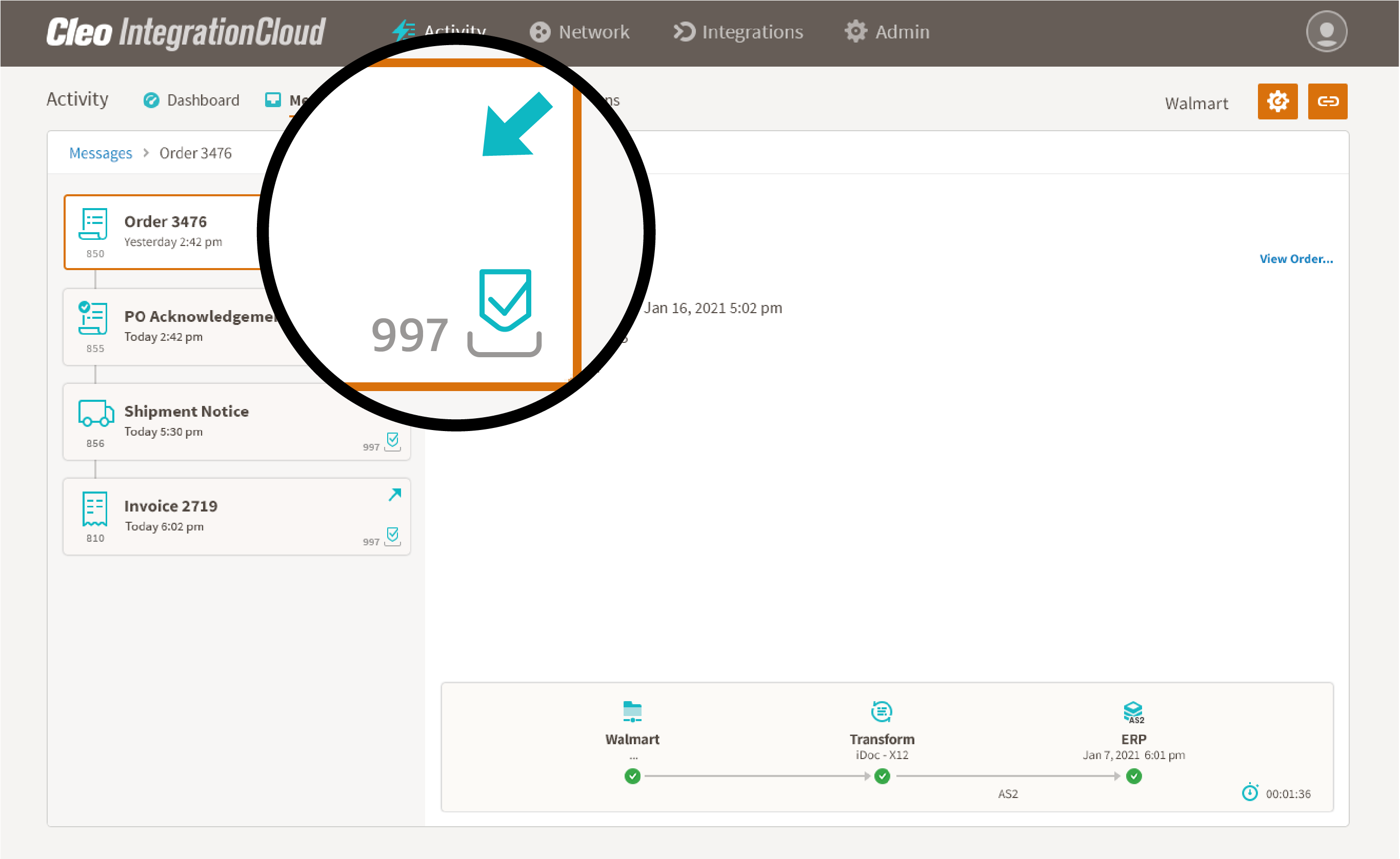
2. EDI 856 Advanced Shipping Notice (ASN): Also known as ASN, this EDI document type is used to notify recipients of an upcoming shipment's details, providing tracking and packing information ahead of delivery. Suppliers or manufacturers send it to customers or retailers, enabling efficient supply chain management and order preparation. In this platform screenshot, Cleo automatically sends out an EDI 856 after creating an EDI mapping route from supply chain visibility software to a trading partner.

3. EDI 810 Invoice: This EDI document type facilitates the exchange of billing information between buyers and sellers. This method of invoicing improves accuracy, speeds up payment cycles, and enhances overall financial visibility for businesses. Typically, a vendor sends a buyer this EDI document indicating how much is owed for goods and/or services and is sent in response to a EDI 850: Purchase Order, which is a request for payment once the goods or services have shipped. They typically contain shipping details, payment terms, information on the goods, and/or services.
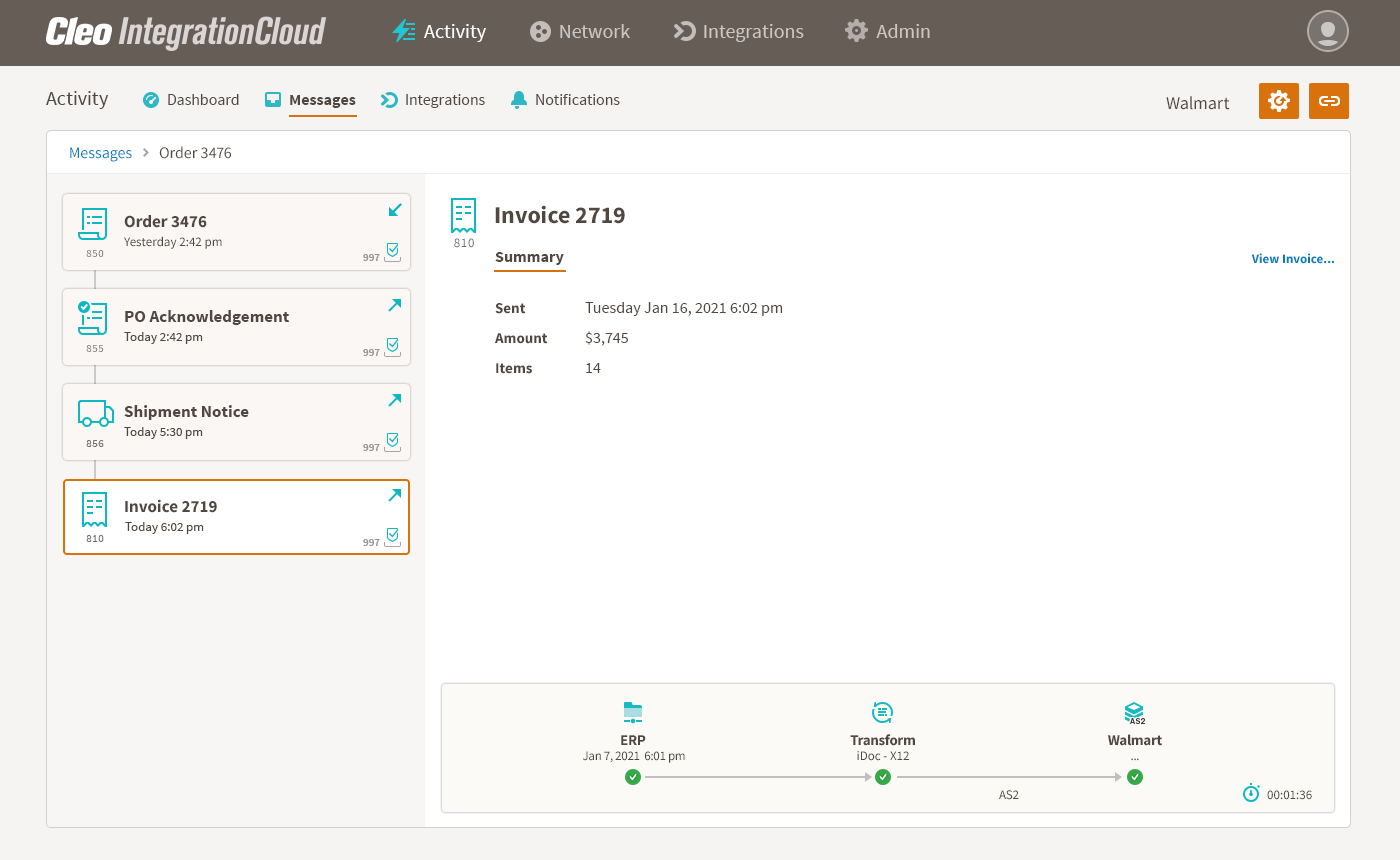
For a more in-depth look at EDI implementation issues, and to help you gain an understanding of other critical electronic data interchange terminology.
Frequently Asked Questions
How much does it cost to implement EDI for a business?
There's no one-size-fits-all answer to the cost of implementing EDI. Several factors influence the total price tag, including:
Deployment Model: Opting for a cloud-based EDI solution typically involves lower upfront costs compared to an on-premise setup. However, cloud options often come with recurring subscription fees.
Transaction Volume: The number of transactions you exchange with trading partners directly affects the cost. Pay-as-you-go models are common, where you pay per transaction or per megabyte of data transferred.
Customization Needs: If your business requires extensive customization to integrate EDI with existing systems, expect higher costs due to development and integration time.
Vendor Selection: Different EDI vendors offer varying pricing structures and feature sets. Comparing quotes from several providers is crucial to find the best fit for your budget and needs.
Instead of focusing solely on the cost, consider the potential return on investment (ROI) EDI can bring. Streamlined processes, reduced errors, and improved efficiency can significantly impact your bottom line, often outweighing the initial investment.
What are the security risks associated with EDI transactions?
While EDI offers numerous advantages, it's essential to be aware of potential security risks:
Unauthorized Access: Hackers can exploit vulnerabilities in your EDI system or your trading partner's system to gain unauthorized access to sensitive data like financial information or intellectual property.
Data Breaches: Malicious actors might target data transmissions to steal or manipulate information, potentially leading to financial losses or reputational damage.
Compliance Issues: Failure to comply with industry regulations or data privacy laws can result in hefty fines and penalties.
Mitigating these risks requires a comprehensive security approach. Implementing robust access controls, encryption, and regular security audits are crucial steps. Additionally, choosing an EDI provider with a strong security track record and adhering to best practices can significantly enhance the security posture of your EDI transactions.
How can I get started with using EDI for my business?
Taking your first steps towards adopting EDI can seem daunting, but following these steps can help you navigate the process smoothly:
- Assess Your Needs: Clearly define your business goals for implementing EDI. What problems are you trying to solve, and what functionalities are essential for your workflow?
- Research and Choose a Vendor: Evaluate different EDI providers based on their pricing models, features offered, industry expertise, and customer support.
- Partner with Your Trading Partners: Discuss your plan to implement EDI with your trading partners and ensure they're compatible with your chosen solution.
- Map Your Data: Identify the data you'll exchange electronically and map it to the relevant EDI standards used by your trading partners.
- Implement and Test: Work with your chosen EDI provider to implement the solution and thoroughly test it before going live.
Remember, implementing EDI is a collaborative effort. By involving key stakeholders within your organization and actively communicating with your trading partners, you can ensure a successful transition to a more efficient and secure business environment.
The Advancement of Modern EDI
For many organizations, modern platforms provide enhanced EDI visibility and greater B2B reliability. Modern platforms are more dependable than newer API-centric methods or relying on value-added networks. This is because the latter options may lack required standards for B2B transactions, necessary EDI documents or can be costly and inefficient, respectively.
To best leverage EDI as a component of a comprehensive B2B integration strategy, a flexible and versatile integration framework that enables B2B ecosystem engagement with EDI capabilities is essential. Further, EDI can no longer be considered as a standalone use case in addressing the expansive demands necessitated when participating in B2B. Other considerations such as protocol depth, application and business connectors, APIs, and governance and security functionality need also be included.
Ultimately, EDI is a category where modern platform integration technology is best suited to solve existing B2B integration challenges while expanding to a variety of new and emerging integration patterns at the edges of traditional B2B and the cloud.
Discover the benefits of using Cleo Integration Cloud for EDI solutions by watching a 3-minute demo video.

About Cleo
